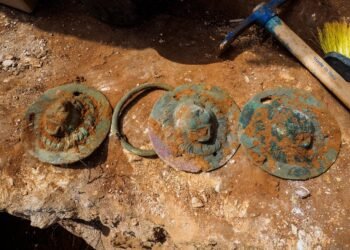According to an announcement by the Rostock City Hall, a devil’s curse tablet dating back to the 15th century has been uncovered in a medieval latrine during construction for the Rostock town hall extension.

The inconspicuous rolled-up lead tablet, initially mistaken for scrap, was found at the bottom of the latrine, revealing a Gothic minuscule inscription that reads, “sathanas taleke belzebuk hinrik berith.” This cryptic message directed a devil’s curse against a woman named Taleke and a man named Heinrich (Hinrik).
The use of Blackletter, also known as Gothic minuscule or Textura, points to the tablet’s origin between the 12th and 17th centuries. Archaeologists leading the excavation, including Jörg Ansorge from the University of Greifswald, emphasized the exceptional nature of this find, considering that curse tablets are more commonly associated with ancient Greek and Roman periods.
Referred to as defixiones in Latin, these lead tablets would be folded or rolled up and hidden in locations believed to serve as gateways to underworld gods who could carry out the curses’ wishes.
While curse tablets were prevalent in antiquity, invoking divine or demonic powers for various purposes such as harming rivals, settling disputes, or securing love, the Rostock discovery is unique for its medieval origin. The rarity of such finds from the 15th century adds to the significance of the discovery.
The motive behind the curse remains speculative, with researchers suggesting possibilities such as relationship interference, spurned love, jealousy, or a desire to bring misfortune upon the named individuals. The invocation of Beelzebub and Berith adds an extra layer of intrigue, with Berith being equated with Beelzebub in Rabbinic tradition.
The curse tablet was discovered during excavations that unveiled the remains of a 14th-century double-gabled house, described as one of the most beautiful in Northern Germany. The site also revealed traces of cellars and foundations dating to the 16th and 17th centuries, a former waterway, and a 15th-century lusterware blue bowl from Valencia, Spain.
According to Ansorge, the discovery challenges the conventional timeline for curse tablets, as similar finds are mostly associated with ancient times, from 800 BCE to 600 CE in Greek and Roman regions. The challenges of finding such tablets are underscored by the intentional placement in locations like latrines, making them difficult or impossible for the cursed individuals to discover.
The tablet’s location in the latrine, considered even closer to the underworld than a well, aligns with the ancient tradition of placing curse tablets in areas associated with chthonic powers. This discovery suggests a continuation of the ancient practice in medieval Rostock, challenging previous assumptions about the decline of lead curse tablets after the early 7th century.
More information: Rathaus Rostock
























